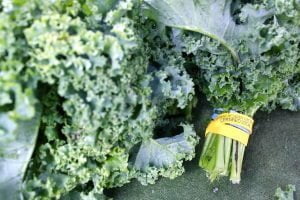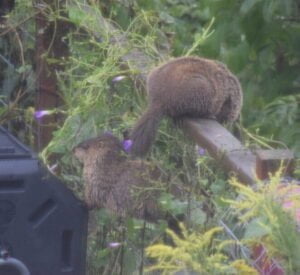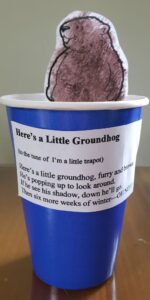This week’s theme is groundhogs. Our “Growing Minds Day by Day” educational resource lists are designed for families and educators.
Books:
 A Garden for Groundhog
A Garden for Groundhog
By Lorna Balian
The O’Leary’s lived on a small farm with their cat, farm animals, and one not-so-welcome guest: a groundhog that liked to eat all of their fresh vegetables every summer. As Mr. O’Leary devises a plan to keep the groundhog from stealing all of their veggies, the readers are able to learn about life on a small farm, the changing seasons, and the mutual relationships humans share with animals. Watch a read aloud on YouTube.
 Geoffrey Groundhog Predicts the Weather
Geoffrey Groundhog Predicts the Weather
by Bruce Koscielniak
Geoffrey Groundhog has become a local celebrity for successfully predicting how long winter will last. Everyone awaits his prediction each February 2, when he emerges from his burrow to look for his shadow. But Geoffrey’s fame has grown out of control—and so has the commotion surrounding his burrow! With television lights and cameras crowding him, he can’t even see the ground, much less his shadow. How will he make his spring prediction? Watch a read aloud on YouTube.
 Grumpy Groundhog
Grumpy Groundhog
by Maureen Wright
It’s Groundhog Day, and everyone is gathered to find out if it’s time for spring. But Groundhog does NOT want to leave his cozy bed in his cozy den. Watch a read aloud on YouTube.
Find more books Visit the Growing Minds’ farm to school literature database to discover more of our favorite children’s books.
Local Food Recipe:
 Massaged Kale Salad
Massaged Kale Salad
If you’ve ever had a groundhog visit your backyard or garden, you know that they love to eat leafy green vegetables! Celebrate Groundhog Day groundhog-style by making a Massaged Kale Salad full of local greens. Leafy greens are packed with vitamins and nutrients and are available at farmers markets throughout the winter. Get the kale salad recipe (developed by Lauren Furgiuele, RDN, LDN of Planting Roots Nutrition). Learn more about kale and other winter greens here.
Not able to get your hands on the vegan brie called for in Lauren’s creamy dressing recipe? Try our recipe for apple salad dressing instead.
Apple Dressing
Ingredients:
- 2 sweet local apples
- 4 Tbsp. apple cider
- 1 Tbsp. apple cider vinegar
- 1 tsp. lemon juice
- 1 tsp. Dijon mustard
- 1/3 cup olive oil
- 1/4 tsp. garlic powder (optional)
- Salt and pepper
Directions:
- Cut apples into small chunks.
- Place 1 cup of apple chunks and apple cider, cider vinegar, lemon juice, Dijon, olive oil, and garlic powder (if using) into a blender and puree until smooth. Add salt and pepper to the dressing to taste.
- Place kale or other salad greens and reserved apple chunks in a large salad bowl.
- Pour dressing over salad and toss to coat.
Educational Resources:
Groundhog Day
Since the 1800s, February 2nd has been celebrated as Groundhog Day in parts of the United States. Legend has it that if a groundhog emerges from his burrow on this date and sees his shadow (because it is a clear, sunny day), we can expect six more weeks of cold winter weather. If he doesn’t see his shadow, we can expect an early spring. The most famous groundhog that participates in this weather predicting tradition is Punxsutawney Phil, a groundhog that resides in the town of Punxsutawney, PA. Wondering how this unusual holiday came to be? Learn more about the history of Groundhog Day at History.com.
Coloring Sheet
In our region, groundhogs may be frequent (if not entirely welcome) visitors to gardens throughout the spring, summer, and fall. Despite their cute appearance, groundhogs can be a pest to farmers and gardeners when they start nibbling (or devouring) the leaves of vegetables and other crops. While groundhogs can be a nuisance to humans, groundhogs also play a role in the natural food web. In honor or Groundhog Day, celebrate these clever critters (and some of the veggies they have been known to munch on) with our Groundhog in the Garden Coloring Sheet (illustrated by Asheville-based artist Kathleen Littlefield).
 Groundhog Facts:
Groundhog Facts:
- Groundhogs go by many names, including woodchuck and whistlepig.
- They belong to the family of large ground squirrels known as marmots.
- Their range includes the eastern US, Canada, and into Alaska.
- Groundhogs are one of the few species that enter true hibernation in the winter.
- Groundhogs dig burrows underground where they sleep, rear their young, and hibernate.
- Groundhogs are primarily herbivorous, eating wild grasses, clover, berries, and other vegetation. They eat agricultural crops when available, to the annoyance of many gardeners and farmers!
- Groundhogs sometimes make a high-pitched whistling sound to alert other groundhogs to danger, hence the common name “whistlepig”.
- Groundhogs will retreat to their burrow or climb trees to escape from predators, which can include red-tailed hawks, bobcats, and foxes. They can easily climb fences (as seen in the photo above!).
Activities:

 Here’s a Little Groundhog
Here’s a Little Groundhog
Materials:
- Groundhog cutout and poem
- Brown paint and brush (optional – add a little sand into the paint to give your groundhog a “fur” texture)
- Paint brush
- Popsicle stick
- Tape or glue
- Scissors
- Paper cup
Directions:
Paint your groundhog. When it is dry, cut it out. Tape or glue your groundhog onto the popsicle stick. Make a small hole in the bottom of your paper cup. Tape or glue the groundhog poem onto your cup. Insert the popsicle stick. Sing the poem while having the groundhog pop its head out of the cup and back down.
Shadow Play:
Shadow Art
Look around you on a sunny day.
You can find shadows everywhere.
You can use real shadows to make shadow art.
Take some paper and a marker with you.
Look for a shadow.
Put a piece of paper over it.
What happens to the shadow?
Use your marker to trace it.
Make pictures of several shadows.
Share your shadow art with your family or class.
See who can guess what made the shadows.
Shadow Puppets
You can make shadows dance!
Go into a dark room.
Put your hand between a wall and a light.
Look for a shadow.
Move your hand around.
Wiggle your fingers.
Move your hand towards the light.
Move it away from the light.
What happens to the shadow?
Now make some shadow puppets of your own.
Cut pictures or shapes out of paper.
Tape them to straws or popsicle sticks.
Use them to make shadows on the wall.
Share your shadow puppets with someone else.
Make shadows together.
—
That’s it for this week. Check back next week for new resources. Click here to access Day by Day resources from past weeks. If you didn’t find what you’re looking for here, please visit our Lesson Plans page.


